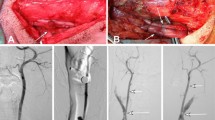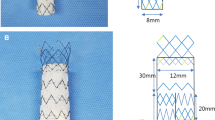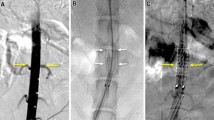Abstract
This study evaluated the deployment and short-term healing of thin-walled expanded polytetrafluoroethylene (ePTFE) stented grafts and covered stents as endoluminal prostheses in normal canine aortas and in an abdominal aortic aneurysm (AAA) model. Stented grafts consisted of a 7 cm length of 3 mm internal diameter ePTFE graft (Impra, Inc., Tempe, Ariz.) with two P-188 Palmaz stents (Johnson & Johnson Interventional Systems, Warren, N.J.) deployed along the inner surface of the ends of the graft to secure the prosthesis to the arterial wall. Covered stents were fabricated by placing a 3.7 cm length of 3 mm internal diameter thin-walled ePTFE graft over a P-394 Palmaz stent. Four covered stents and four stented graft prostheses (two of each prototype in the normal canine aorta and AAA model) were implanted in eight animals. One prosthesis of each type in each model was removed at 30 days and one at 60 days. Prior to removal, prostheses were evaluated by CT scan, arteriography, and intravascular ultrasound imaging with values compared to those obtained when the prostheses were deployed. Gross inspection and microscopic evaluation were performed at scheduled explantation. In general, the stented grafts were more difficult to accurately deploy. Healing and maintenance of long-term patency without significant luminal obstruction or occlusion occurred in only one 30-day sample in a normal canine aorta. The 30-day stented graft specimen that had been implanted in an AAA and required the addition of a covered stent to seal a maldeployment of the distal segment was also patent. The 60-day stented graft in the normal canine aorta was occluded with narrowing of the graft between the stents. The 60-day stented graft in the AAA was patent with one central fold and thrombus occupying approximately 20% to 30% of the lumen at this site. In contrast, the covered stent devices were less difficult to accurately deploy. All of the covered stent devices were patent with well-incorporated surfaces. Deployment of covered stents was more accurate and less complicated compared to stented grafts. All patent endoluminal prostheses and stent surfaces were well incorporated into aortic tissues. Problems with graft narrowing, folding, and subsequent thrombosis occurred in the unstented segments of the stented grafts. These preliminary findings support the further development and use of completely supported (stented) devices as endoluminal prostheses.
Similar content being viewed by others
References
Palmaz JC, Tio FO, Laborde JC, et al. Use of stents covered with polytetrafluoroethylene in experimental abdominal aortic aneurysm. J Vasc Intervent Radiol 1995;6:879–885.
Verbin C, Donayre C, Kopchok G, et al. An anterior patch aortic aneurysm model for the study of endoluminal grafts. J Invest Surg 1995;8:381–388.
Lazarus HM. The EVT endoluminal prosthesis: Developmental concepts and design. In Chuter T, Donayre C, White R, eds. Endoluminal Vascular Prostheses. Boston: Little, Brown, 1995, pp 81–105.
Chuter TAM, Green RM, Ouriel K, et al. Transfemoral endovascular aortic graft placement. J Vasc Surg 1993;18:185–197.
Parodi JC. Endovascular repair of abdominal aortic aneurysms. Adv Vasc Surg 1993;1:85–106.
Cragg A, Dake M. Percutaneous femoropopliteal graft placement. J Vasc Intervent Radiol 1993;4:455–463.
Piquet P, Rolland P, Bartoli J, et al. Tantalum-Dacron coknit stent for endovascular treatment of aortic aneurysms: A preliminary experimental study. J Vasc Surg 1994;19:698–706.
White RA, Verbin C, Kopchok G, et al. Role of cinefluoroscopic and intravascular ultrasound in evaluating the deployment of experimental endovascular prostheses. J Vasc Surg 1995;21:365–374.
McGahan TJ, Berry GA, McGahan SL, et al. Results of autopsy at 7 months after successful endoluminal treatment of an infrarenal abdominal aortic aneurysm. J Endovasc Surg 1995;2:348–355.
White RA, Donayre CE, deVirgilio C, et al. Histopathologic evaluation of an endoluminal vascular prosthesis used to repair an iliac artery aneurysm. J Endovasc Surg (in press).
Author information
Authors and Affiliations
Additional information
Supported by Impra, Inc., Tempe, Ariz.
About this article
Cite this article
White, R., Kopchok, G., Zalewski, M. et al. Comparison of the deployment and healing of thin-walled expanded PTFE stented grafts and covered stents. Annals of Vascular Surgery 10, 336–346 (1996). https://doi.org/10.1007/BF02286777
Issue Date:
DOI: https://doi.org/10.1007/BF02286777




